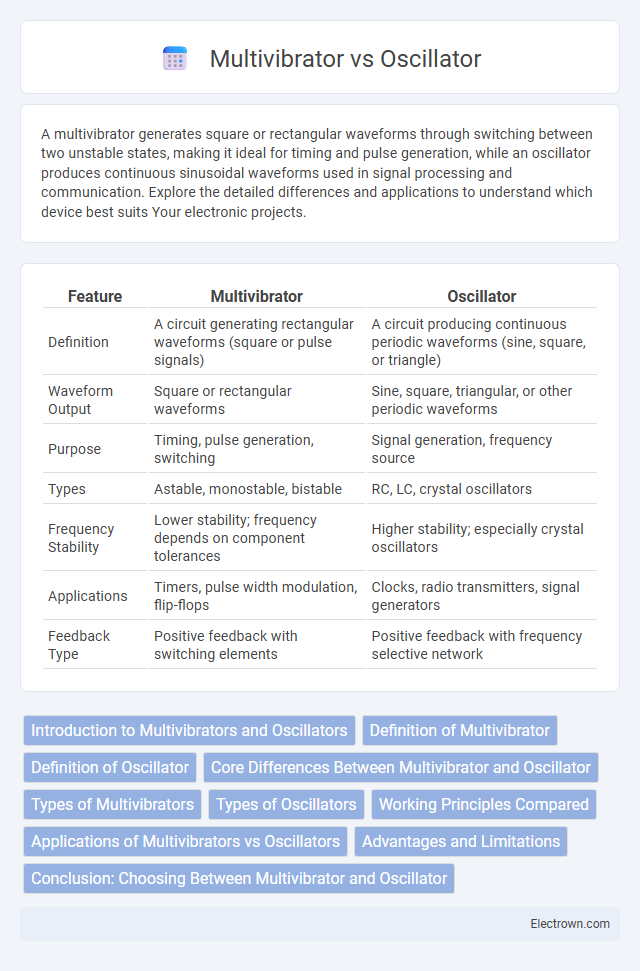A multivibrator generates square or rectangular waveforms through switching between two unstable states, making it ideal for timing and pulse generation, while an oscillator produces continuous sinusoidal waveforms used in signal processing and communication. Explore the detailed differences and applications to understand which device best suits Your electronic projects.
Table of Comparison
| Feature | Multivibrator | Oscillator |
|---|---|---|
| Definition | A circuit generating rectangular waveforms (square or pulse signals) | A circuit producing continuous periodic waveforms (sine, square, or triangle) |
| Waveform Output | Square or rectangular waveforms | Sine, square, triangular, or other periodic waveforms |
| Purpose | Timing, pulse generation, switching | Signal generation, frequency source |
| Types | Astable, monostable, bistable | RC, LC, crystal oscillators |
| Frequency Stability | Lower stability; frequency depends on component tolerances | Higher stability; especially crystal oscillators |
| Applications | Timers, pulse width modulation, flip-flops | Clocks, radio transmitters, signal generators |
| Feedback Type | Positive feedback with switching elements | Positive feedback with frequency selective network |
Introduction to Multivibrators and Oscillators
Multivibrators are electronic circuits used to generate square, rectangular, or pulse waveforms, functioning as switches or timers in digital electronics. Oscillators produce continuous periodic waveforms such as sine, square, or triangle waves, serving as signal generators in communication systems and clocks in microprocessors. Multivibrators include types like astable, monostable, and bistable configurations, while oscillators encompass crystal, LC, and RC oscillators based on their frequency stability and waveform purity.
Definition of Multivibrator
A multivibrator is an electronic circuit used to implement basic timing functions by generating square or rectangular waveforms with specific frequency and duty cycle. Unlike oscillators that produce continuous sine waves, multivibrators toggle between two states, making them ideal for pulse generation, clocks, and digital logic applications. Your projects requiring precise timing or switching signals often utilize multivibrators for efficient and reliable performance.
Definition of Oscillator
An oscillator is an electronic circuit that generates a continuous, periodic waveform without any external input signal, typically producing sine, square, or triangular waves at a specific frequency. It converts direct current (DC) from a power supply into an alternating current (AC) signal with a defined frequency, essential for clock generation, signal processing, and communication systems. Unlike a multivibrator, which produces non-sinusoidal pulses or switching signals, an oscillator emphasizes stable and steady waveforms used as carrier signals.
Core Differences Between Multivibrator and Oscillator
A multivibrator is a type of electronic circuit used to generate square, rectangular, or pulse waveforms by switching between two states, while an oscillator produces continuous periodic signals such as sine, square, or triangle waves. The core difference lies in their operation: multivibrators are primarily used for timing, switching, and waveform generation in digital applications, whereas oscillators provide stable frequency signals essential for communication and signal processing. Your choice depends on whether you need simple pulse generation (multivibrator) or continuous, stable oscillations (oscillator).
Types of Multivibrators
Multivibrators are electronic circuits used to generate square waves and are classified into three primary types: astable, monostable, and bistable. An astable multivibrator oscillates continuously without any external trigger, producing a free-running waveform. Monostable multivibrators generate a single pulse in response to an input trigger, while bistable multivibrators have two stable states and switch between them when triggered.
Types of Oscillators
Types of oscillators include sinusoidal oscillators like RC, LC, and crystal oscillators, which generate continuous waveforms with stable frequencies used in communication and signal processing. Multivibrators, including astable, monostable, and bistable types, act as non-sinusoidal oscillators producing square or rectangular wave outputs for timing and switching applications. Understanding the differences helps you select the right oscillator type for precise frequency control or pulse generation in electronic circuits.
Working Principles Compared
Multivibrators operate by switching between two unstable states, producing square or rectangular waveforms through charging and discharging capacitors in feedback loops. Oscillators maintain continuous, periodic wave generation by using positive feedback in resonant circuits, such as LC or RC networks, ensuring stable sinusoidal output. The key distinction lies in multivibrators' reliance on bistable or astable states for timing pulses, whereas oscillators emphasize sustained oscillations for frequency stability.
Applications of Multivibrators vs Oscillators
Multivibrators are widely used in timing circuits, pulse generation, and waveform shaping applications due to their ability to produce stable square or rectangular waveforms. Oscillators, on the other hand, are essential in generating continuous periodic signals for applications such as clock generation, radio frequency transmission, and signal synthesis. Your choice between a multivibrator and an oscillator depends on whether you need precise timing pulses or a stable sinusoidal output for electronic circuits.
Advantages and Limitations
Multivibrators offer simplicity and ease of implementation for generating square wave signals, making them ideal for timing and pulse generation applications. Oscillators provide stable and continuous waveform outputs, such as sine waves, crucial for communication and signal processing tasks, but they often require more complex circuitry. While multivibrators excel in digital environments with fast switching, their output lacks frequency stability compared to oscillators, which, although more stable, may consume higher power and demand precise component selection.
Conclusion: Choosing Between Multivibrator and Oscillator
Selecting between a multivibrator and an oscillator depends on the application's frequency accuracy and waveform requirements. Multivibrators are ideal for generating square waves and timing pulses with moderate frequency stability, making them suitable for digital circuits and timing applications. Oscillators provide highly stable sinusoidal signals with precise frequency control, essential for RF communication, signal processing, and clock generation.
Multivibrator vs Oscillator Infographic

 electrown.com
electrown.com